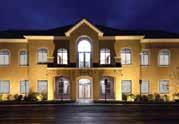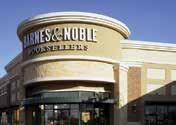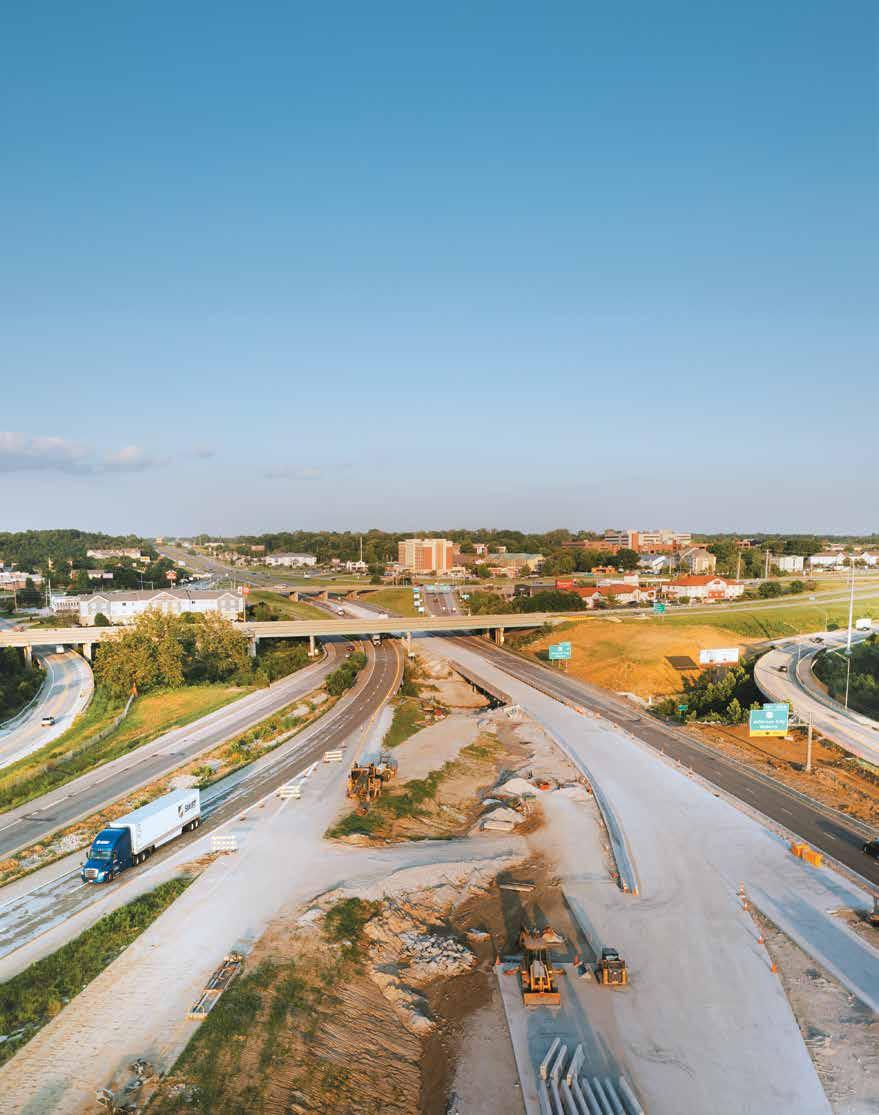

Transit in Transition
I-70, the transportation corridor that has fueled Columbia’s past and present, is getting a generational makeover.















PUBLISHING
David Nivens, Publisher david@comocompanies.com
Chris Harrison, Associate Publisher chris@comocompanies.com
EDITORIAL
Jodie Jackson Jr, Editor jodie@comocompanies.com
Kelsey Winkeljohn, Associate Editor kelsey@comocompanies.com
Karen Pasley, Contributing Copyeditor
DESIGN
Jordan Watts, Senior Designer jordan@comocompanies.com
MARKETING
Charles Bruce, Director of Client Relations charles@comocompanies.com
Kerrie Bloss, Account Executive kerrie@comocompanies.com
CONTRIBUTING PHOTOGRAPHERS
Keith Borgmeyer, Jodie Jackson Jr, Sterling Nivens, e State Historical Society of Missouri
CONTRIBUTING WRITERS
Matt Fetterly, Lauren Sable Freiman, Andrew Grabau, Jodie Jackson Jr, Brandon Knight, Matt McCormick, David Nivens, Steve Spellman, Tim Teddy, Brian Toohey
SUBSCRIPTIONS
Magazines are $5 an issue. Subscription rate is $54 for 12 issues for one year or $89 for 24 issues for two years. Subscribe at comobusinesstimes.com or by phone. COMO Business Times is published monthly by e COMO Companies.
OUR MISSION STATEMENT
COMO Business Times and comobusinesstimes.com strive to be Columbia’s leading source for timely and comprehensive news coverage of the local business community. is publication is dedicated to being the most relevant and useful vehicle for the exchange of information and ideas among Columbia’s business professionals.
Copyright e COMO Companies, 2025
All rights reserved. Reproduction or use of any editorial or graphic content without the express written permission of the publisher is prohibited.
FEEDBACK
Have a story idea, feedback, or a general inquiry? Email our editor at Jodie@comocompanies.com.
CONTACT
e COMO Companies | 404 Portland, Columbia, MO 65201 573-577-1965 | comomag.com | comobusinesstimes.com
There’s a LOT missing from this issue of COMO Business Times and COMO Magazine.
Stay with me here, because that’s obviously not the best way to start this month’s ChatCBT editor’s letter. When we started planning the “Legacy” issue several months ago, the first list of story ideas quickly filled more lines than we knew there would be room for in the magazine. That list continued to grow as our advisory boards chimed in with their invaluable suggestions and insight.
This bumper crop of incredible ideas is a good problem to have, right? After all, chronicling Columbia’s rich, invigorating, yet challenging history could fill several years’ worth of monthly magazine editions.
We have a recap of the “Voices of Columbia,” and you’ll see familiar faces like Paul Pepper and Chris Gervino. When we crowdsourced for suggestions for the “Voices” story, some folks mentioned current news anchors and reporters. That got me thinking about a “Voices” story someone might write thirty or forty years from now. Will those still-new-onthe-scene anchors and reporters be in that legacy issue?
We also feature Columbia’s food legacy, so apologies in advance if the story only skims or skips any of the eateries that are skimmed or skipped only because we have limited space. The same goes for sports personalities, and the surging media presence of one Sophie Cunningham, Columbia’s homegrown basketball belle who is now the enforcer against those who dare take pot shots at WNBA all-everything Caitlin Clark. (For the record, I’ve been a WNBA follower since the league was started.) Sorry, Sophie, but you’re on the short list for future stories about Columbia’s most notable heroes.
What you WILL see are stories about Interstate 70 and the University of Missouri. Without either, Columbia wouldn’t be, well, Columbia. That’s also true for former city manager Ray Beck, the subject of a new biography-memoir — Fingerprints and Footprints: Ray Beck’s Columbia — penned by yours truly in cooperation with ol’ Beck, the farm boy from Miller County who helped orchestrate Columbia’s growth and gave stability to our city government from 1960 to 2006.
As you dig into our deep dive stories, don’t hesitate to make a mental (or literal) list of Columbia’s legends and legacies — then I’d love to see what you’ve got. It only seems reasonable that we create a new department for the magazine focused on our legends and legacies. Stay tuned.
LETTERS TO THE EDITOR
Another great issue! (May 2025, The Downtown Issues.) The COMO and CBT really do an outstanding job of telling the story of Columbia. Thank you for giving Sharp End its proper due. It’s an important history that needs to be remembered and promoted as the incubator moves forward.
And thank you so much for including the story of Missouri UMC’s family life center reopening and the link to the full story online. (COMO Magazine, As Seen Online, page 44, “Soggy Opportunity: Water damage brings new life to MUMUC.”) It looked fantastic. We’re honored to be associated with your publication this month.
— Fred Koenig, Editor, Missouri Conference
Hi there,
I just wanted to send a quick note to say how obsessed I am with your article, “Customer Service With a Purr” (comobusinesstimes.com, June 11). I stumbled across it and instantly felt like I was getting a little tour of the sweetest corners of CoMo.
The idea of a peacock welcoming customers or a shop cat supervising brewery pest control operations? That’s exactly the kind of small-town magic that makes Columbia feel like home. I’ve already bookmarked the story and plan to read it once a day like a good luck charm. It’s that heartwarming.
Thank you for spotlighting the furry and feathered coworkers that make our local businesses even more lovable. I’d love to see more stories like this! The ones that celebrate the everyday charm of our community.
Keep up the wonderful work!
— Sofi, A happy reader in CoMo
Just read “Connected By Design” the June 2025 COMO Magazine article about the Columbia trail system by Marcus Wilkins. Great work! I really enjoyed the deep dive on geography and history. It captured the current momentum in our community beautifully.
— Mike Burden, CEO, Local Motion
Hi Jodie,

JODIE JACKSON JR EDITOR jodie@comocompanies.com
Finally, it deserves more than a passing mention that legacies aren’t always happy and inspiring. In May, super scribe Rudi Keller wrote a feature on Columbia’s Sharp End, highlighting a legacy that deserved our better angels and not the devastating process known as “urban renewal.” May we today search for and commit to opportunities for restoration and to recognize destruction before it comes, and to be on the side of history that, one day, will let us look back on our past without avoiding direct eye contact with Father Time.
I’m on a train, somewhere between Budapest and Prague, and I pulled out the June 2025 issue of COMO Magazine that I thankfully remembered to stuff in my bag when I left Como a few weeks ago. I was so touched by your story (“ChatCBT: I saved your life, we stole a pack of cigarettes,” page 5) and shared it with my seat mates … a man from Vienna and a man from Paris, struggling through translation of English/ German/French. I bet you never thought your words would be shared rumbling through the countryside of Hungary … but here I am. Thank you for sharing such a heartwarming story from your childhood.
— Tina Thompson
CBT’s Advisory Board
CBT’s advisory board is made up of industry leaders and small business owners who help ensure CBT’s content is relevant to our local business community.

















Jay
What’s In Our Name? Our City’s Vibrant Legacies.
Every city carries with it a story — not just of where it is, but how it became. In this issue of COMO Business Times, we explore the legacy of our city.
We call this the “Legacy” issue because it highlights the deep-rooted histories and forward thinking that have given us the city we have today — and into the future. Legacy isn’t about nostalgia; it’s about honoring what came before while building what comes next.
Take, for example, the I-70 corridor — a vital artery that has long connected Columbia to the rest of the Midwest. Today, with major construction underway, we’re witnessing a new chapter in how commerce, commuting, and connectivity will look for the next generation. This isn’t just road construction — it is the physical imprint of progress and planning for the future.
Meanwhile, in a fascinating dive into local history, we explore the former townships and communities that have been annexed into Columbia over the years, as well as place names that no longer exist but remain as rural areas outside our city limits. Names like Harg, Providence, or Oldham may no longer show up on a map, but they remain woven into the fabric of our neighborhoods and business districts. Understanding the role of these communities in our history is essential to understanding where we’re going.
And of course, no legacy discussion would be complete without the University of Missouri. For more than 180 years, Mizzou has been the intellectual and economic
engine of our city — its influence on our workforce, business climate, and civic identity is unmatched. This feature looks at not just the institution’s past, but how its alumni, faculty, and research continue to shape Columbia’s future.
Are we still “Columbia” without Mizzou? Not to be overshadowed, Columbia College and Stephens College also have long, illustrious histories that have melded with MU to make us a college town with multiple layers. Take away the student populations and the dollars that recirculate in our community as a result of these institutions, and Columbia would not be Columbia.
Legacy isn’t about nostalgia; it’s about honoring what came before while building what comes next.
Whether you’re a lifelong Columbian or a newcomer looking to plant roots, we hope this issue helps you appreciate the layers of story beneath our streets, businesses, and institutions. Legacy is something we inherit, but it’s also something we create every day. It is also something we pass along, so let’s try to remember that and treat it as a sacred trust, knowing that our footprints — both literal and figurative — are still telling and carving out additional layers.
Thanks for being part of our story — and for building the next chapter with us.

DAVID NIVENS PUBLISHER david@comocompanies.com
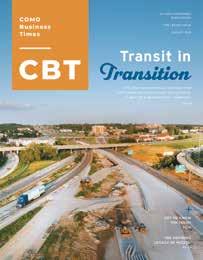
ON THE COVER
I-70, the transportation corridor that has fueled Columbia’s past and present, is getting a multi-billion dollar makeover for future generations of motorists.
Photo by Keith Borgmeyer

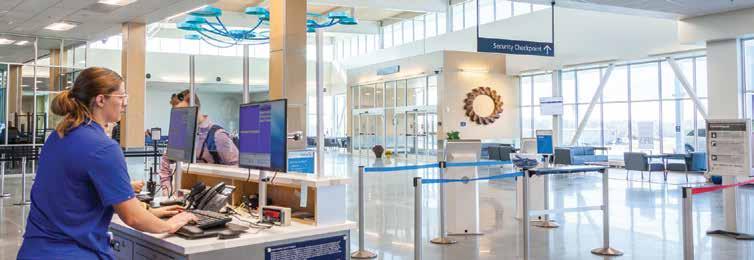
WE BUILD
Nabholz is driving Missouri’s construction industry forward. We perform jobs with our people, clients, and communities in mind — delivering high-quality work that leaves all parties satisfied with the final product for years to come.
Columbia Regional Airport, Columbia

Exterior of the Memorial Union tower from the west, under construction. Photo provided by The State Historical Society of Missouri
Closer Look


RW CLEANING SERVICES LLC
Rhonda Wyatt decided to take her home cleaning business RW Cleaning Services full-time in the beginning of 2024 after ve years of cleaning on the side of her restaurant job to help support her two teenage children. Now, she serves both residential and commercial customers in Columbia and the surrounding areas.
“A clean space brings comfort, peace of mind, and a better quality of life,” Wyatt said.
In 2025, RW Cleaning Services LLC made the top ve among best cleaning services in Columbia. rough her home cleaning services, Wyatt hopes to create a safe, healthy, and welcoming environment.
Wyatt said clients tell her that she brings them peace of mind and relaxation, not just a clean house.
Currently, as a solo business owner, Wyatt is fully booked, though she hopes to expand and grow her cleaning business.
“I feel like being a solo cleaner sets me aside from the bigger cleaning companies,” she said. “It allows me to connect with my clients more.”
R.W.Cleaningservicesllc@gmail.com | FB: RW Cleaning Services LLC
PRESLEY SKINCARE
In 2022, Lesley Adams opened Presley Skincare, a Latina-owned skincare business. After struggling with acne, and trying many quick xes, Adams wanted to nd a better and more holistic way to cure acne problems.
Her mission is to help others nd long-term skin health and con dence. Now as a licensed esthetician, certi ed acne specialist, and mom of four, she is able to accomplish that dream.
“I am passionate about helping others feel con dent in their skin by listening to their unique concerns and o ering personalized care that actually works,” Adams said.
Her business is an evidence-based, holistic skincare studio that blends Korean skincare practices with advanced modalities and intentional self-care. She specializes in corrective facials, acne bootcamp programs, micro needling, and body sculpting.
“Clients often say their skin and soul feel recharged after every visit,” she said.
Presley Skincare hopes to educate and support clients with treatments that help them “glow” both inside and out.
“I truly believe: Nothing changes if nothing changes. Whether you’re struggling with acne, signs of aging, or just need time to reset. I am here to walk alongside with you on your skin journey,” she said.
914 N. College Ave, Suite 5, Columbia, MO 65201 (573) 489-0991 | presleyskincare.glossgenius.com CBT
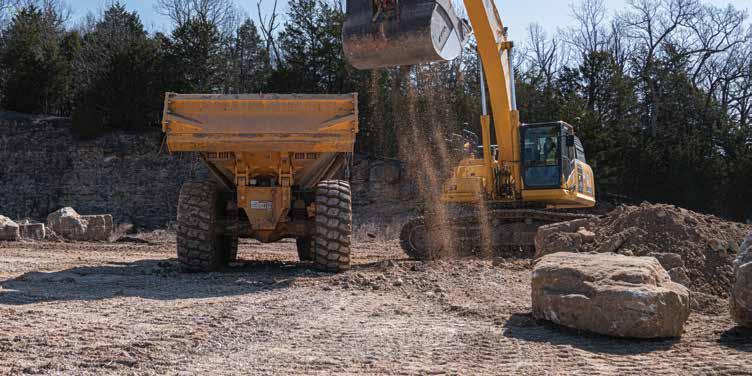


Owning COMO
Navigating Columbia’s vacant space.
BY LAUREN SABLE FREIMAN
PHOTOS BY STERLING NIVENS
COLUMBIA IS A CITY that is rapidly expanding, and with that growth comes plenty of opportunity for those looking to own commercial or retail property.
“ ere is land available for sale in our community,” says Mike Grellner, vice president of Plaza Commercial Realty.
However, those hoping to open a business or expand their real estate portfolio will likely have to be open to exploring options outside of the some of the city’s most desirable corridors.
“If you want to own land that is suitable for o ce, retail, or industrial space and you’re open to where that would be in the Columbia Metropolitan Statistical Area, the opportunities are abundant,” Grellner notes. “But if you want to be on Stadium Boulevard near the mall or on Providence and Grindstone, there are little to no opportunities to own. e more exible you are with geography, the more opportunities there are,” he says.
Because Columbia is a growing community with a growing population, other commercial and retail pockets will inevitably sprout up around town. However, it’s too early to predict where those hot spots will emerge.
“We don’t necessarily know where they are yet,” Grellner admits. “ ey will show up, not overnight, but over the course of years.”
Grellner has had many clients who recall eyeing a piece of property around Providence and Grindstone or other key intersections around the city.
“A lot of businesses that would like to be in that area right now remember that one lot they wish they had acted on,” Grellner says. “ ere are a lot of businesses in town that have a story like that.”
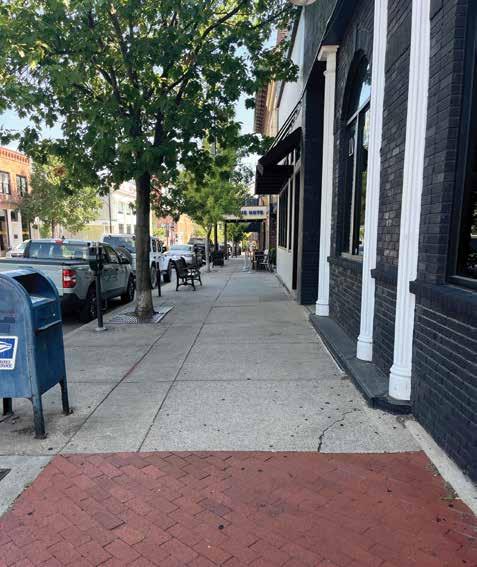



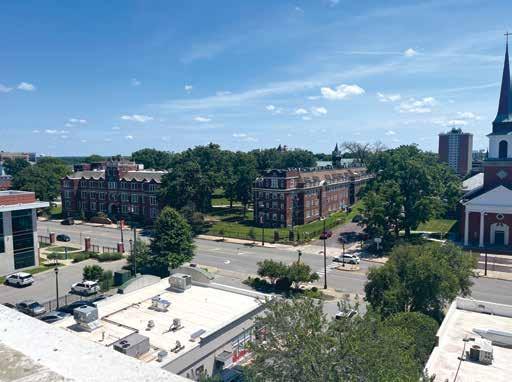
FINDING THE RIGHT PARTNERS
e best course of action for those exploring the idea of property ownership is to assemble a team of experts with the specialized knowledge to make the search go smoothly.
“ e rst phone call should be to a business banker,” Grellner advises. “Often we get a phone call from someone who wants a property, but it doesn’t matter if you want it if you can’t a ord it.”
While a business owner may think they have the money to purchase a speci c property, that could change once they talk to a banker. A banker may also be able to provide options that could help make a property more a ordable or property ownership more attainable.
“ ere are some small business loans or grants through the city, or some potentially through the state, though those are minimal,” Grellner says. “It is usually more about the Small Business Administration programs, and the federal programs for buying real estate are run through local banks.”
Once a business banker gives the goahead — and likely some parameters — to begin a real estate hunt, he says the next step is to reach out to a commercial real estate broker.
“It’s an intimidating process for a business owner, someone who owns an ice cream shop or a life insurance o ce, to get started with the process of identifying the right commercial real estate,” Grellner notes. “Our role as commercial brokers and consultants is to break down those barriers and simplify the process, and that is really the value we bring.”
Business owners or district managers are typically so focused on the dayto-day operations that they don’t have time to search online listings or multilist services. at’s where the insight and expertise of a commercial broker can prove valuable.
“We are really consultants for business owners and corporate managers, and the consultation we o er is ‘Tell us what you need, even if you don’t know exactly’” Grellner says. “Do you need more space or want to be in a certain area? We work on a consulting basis to identify the properties that make sense for them.”
Once a broker identi es properties, the process continues to move forward.
“You’ve got to walk around the outside, walk around the inside, touch it and feel it, and determine if it is the right location
“If you want to own land that is suitable for office, retail, or industrial space and you’re open to where that would be in the Columbia Metropolitan Statistical Area, the opportunities are abundant.”
– MIKE GRELLNER
and what improvements you might put in there to make it suitable for your business occupancy,” Grellner says. “Some owners will do that for you, some won’t. We help you with how to approach that.”
Grellner estimates that buying a piece of land and then constructing a building in Columbia is a two-year endeavor. Searching for the perfect piece of property is typically a three- to six-month process, followed by putting it under contract and closing on the property sixty to ninety days later. Once the property closes, the owner is then able to begin the building or renovation work.
As a commercial broker, Grellner says that his role typically ends once the property transfers to its new owners. At that point, the owner is usually working with their contractor and banker to nalize construction plans. However, he remains available to help his clients navigate what can be a confusing process.
“We’re conscious about the perception of sitting at the closing table, collecting a check, and going tap dancing down the street,” he says. “We are adamant that any issue you run into, we are here to quarterback the process after the fact.” CBT
Why Your Listing Should Hit the Open Market
BY BRIAN TOOHEY
RECENTLY, A NATIONAL REAL ESTATE BROKERAGE led a lawsuit against Zillow, which has garnered national attention. e suit challenges a new rule Zillow is implementing, which requires that any listing receiving public marketing be uploaded to Zillow within one day. If the listing isn’t uploaded within that time, Zillow won’t allow it to be displayed at all.
Zillow argues that its rule is better for consumers because it ensures all buyers have access to every available listing. e brokerage’s suit claims Zillow’s new rule forces home sellers to have their listings displayed on Zillow’s websites and limits options for how a seller wants to market their home. is raises a bigger question: Why wouldn’t a seller want their listing to reach the entire market? And, more critically, is it truly in the seller’s best interest — or the broker’s — to limit market exposure?
Locally, REALTORS must follow a “Clear Cooperation” policy mandated by the National Association of REALTORS (NAR). is policy was introduced because listings were excluded from Multiple Listing Services (MLS) and shared only with a small group of agents and buyers during periods of low market inventory. e policy aims to benet homebuyers and sellers by providing maximum exposure for listings, ensuring that local real estate markets serve consumers as e ectively as possible.
Listings that hit the open market have greater exposure to buyers searching for a home. is can increase the likelihood of multiple o ers, leading to better terms and a higher selling price for sellers. A 2021 study by NAR found that homes listed in the MLS and given full market exposure
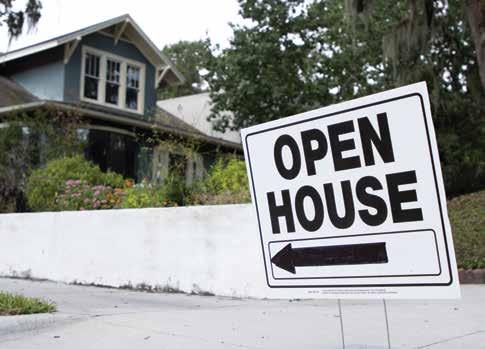
sold for 17 percent more on average than homes sold o -market. Selling on the open market is the best way to maximize the sale price by encouraging competition and increasing market visibility.
While selling a home o -market doesn’t violate Fair Housing laws, the way the sale is conducted can. Limiting exposure to the open market can inadvertently reduce access for people in protected classes, potentially leading to Fair Housing Act violations. Even if unintentional, such practices can be interpreted as steering or discriminatory exclusion.
A seller may also receive better representation from their agent with an open market sale. Missouri real estate law permits dual agency, which means the same agent or brokerage represents both parties in a transaction, provided both parties agree. ere can be advantages to dual agency, such as potentially more negotiable com-
missions and more streamlined communication between the buyer and seller. However, con icts of interest can arise, and a dual agent has a limited duciary duty to both parties, which can reduce the level of advice an agent can provide. Dual agency can also potentially bene t the selling agent more than the seller if they receive a commission from the buyer and seller for the same transaction.
O -market sales may appeal to sellers seeking privacy, fewer showings, or a quick sale. But these perceived conveniences often come at a hidden cost: lower sale prices, increased legal risk, and reduced professional guidance.
For most sellers, the advantages of going to the open market far outweigh the drawbacks. Broad exposure attracts more buyers, creates competition, and increases the likelihood of a smooth and pro table sale. CBT

Brian Toohey is the Chief Executive Officer for the Columbia Board of REALTORS®.
What Could Be Built Here?
BY ANDREW GRABAU
THERE’S A LARGE VACANT LOT a few blocks from my house in central Columbia that’s been empty for years. I’ve heard various stories about how it might be developed. Rumors of a large apartment complex, individual market-rate homes, or a mixed-use commercial and residential project. Every time I pass it or sit at the intersection, I think about how this is a missed opportunity to do something — anything — let alone something that could transform individuals and our community. Instead, it’s still just a huge chunk of grass that takes a long time to mow.
I believe it is vacant not because people do not care about what happens there. ey (whoever the owners are) likely want to see it used for something bene cial. But I think it’s more about our community’s challenge to ask what could be built here and then act on it because like many things, building something meaningful has become harder than it should be. is lot is just one example of what I see throughout our community. It’s also a symbol of the systems we’ve inherited. Whether it’s housing, workforce development, or education, too many plans and intentions get stuck. And when we fall back on the idea that there’s just not enough — enough land, enough funding, enough people, enough nancial resources, we reinforce a scarcity mindset and the belief that “it is what it is.”
ere is a di erent way to think about community opportunities and progress. Ezra Klein, in his book Abundance, highlights this and argues that we have forgotten how to build all sorts of things. His call isn’t partisan or ideological, it’s about recovering the belief that our systems can work if we align them to create opportunities at scale. Some might claim this book or this idea is an attack on the

e ciencies of government. My point in referencing it is to share my belief that we should strive to and can do big things together. is requires us to reexamine the limitations that have become systematic barriers and to be open to a different mindset.
is kind of mindset is at the heart of what some call an Abundance Agenda. It’s not a slogan, it’s a challenge: What happens when we stop saying “no, because” and start saying “yes, if”? What becomes possible when communities work to unlock resources, remove roadblocks, change systems, and maximize what we already have?
In Boone County, we are already seeing this shift. Projects like the Boone County’s Upward Mobility Initiative are tackling root causes of poverty, not just symptoms. e Boone Impact Group is modeling public-private collaboration and raising the capacity, therefore the impact, of nonpro ts through greater collaboration. However, despite these and other e orts designed to increase upward mobility, continued challenges have made it hard to signi cantly scale these and other promising e orts.
At the William Guitar Little Foundation, we see recognizing this as a call to action and an opportunity to be a part of the momentum. Our role isn’t to lead all e orts, it’s to help accelerate what’s already taking shape and support new innovative e orts to ourish. We believe in investing in organizations that raise the bar, that take smart risks, and that measure what matters. It’s what’s possible when community leaders, nonpro ts, government, and business all pull in the same direction.
But to move from scarcity to abundance, we will all need to stretch. Local government must rethink how policy can enable rather than delay. Nonpro ts must think beyond sustaining and toward transforming. And residents — all of us — must remain open to growth that serves the whole community, not just our own corner of it.
at empty lot near my home is still waiting to become something transformational. Likewise, I believe our community can also be transformed. But it will not be decided by what we say “no” to, but by what we have the courage to say “yes” to and build together. CBT

Andrew Grabau is the executive director of the William Guitar Little Foundation.
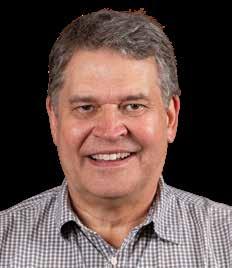
Tim Teddy
Former Director, City of Columbia Community Development Department
You retired effective July 7 after twenty years of service to the city. What made this the time to retire — and when did you make that decision? In December, I turned 65 and started getting junk mail on retirement plans. I had worked in local government nonstop for 35 years. Mind and body craved a change. I gave my sixmonth notice on New Year’s Eve.
What other roles did you fill during your time with the city? I had only one other job title, and that was Planning & Development Director. Until 2011, I managed a smaller department that did planning, zoning, and federal grants through U.S. Housing and Development. I wore a few hats, such as chairing the technical committee of our transportation planning body, serving as oodplain administrator, and sta liaison to the ward redistricting committees after the 2010 and 2020 censuses.
Describe the role of community development director. e community development director is responsible for directing, coordinating, and reporting on long-range development plans, the review of private development, construction permits, and inspections.
When it comes to community development and building permits, the topic that jumps out to us is the 2017 overhaul of the city’s zoning codes. Take us through that process: Why did it occur, how it was achieved, and what improvements did it create? It had been decades since the city overhauled its zoning and other development ordinances. Initially we responded to emerging issues: outdoor lighting, stream bu ers, steep slopes, soil stockpiling, procedural improvements, downtown signs, and others. e new comprehensive plan, Columbia Imagined, recommended new approaches to land use regulation. We engaged a consultant, and their draft of the Uni ed Development Code made approximately 1,000 revisions to the city’s code. e Planning & Zoning Commission and their liaison examined approximately 200 of those changes in greater detail and worked overtime to recommend further revisions in response to public input. After several public workshops and public hearings, the City Council adopted the UDC in March 2017.
What are some things the public or even builders/developers might still not understand about the new UDC or the process that went into overhauling it? e UDC can be revised from time to time to keep up with emerging trends. For example, the 2017 ordinance permitted smaller, slimmer house lots, but only by special request in two-family dwelling districts. After approval of more than 300 lots in this format, sta and the Planning & Zoning Commission are working on integrating smaller lots in our extensive single-family districts.
The city has a long history of growth by annexation. What were some annexations that occurred under your watch? During my tenure, the city annexed approximately seven square miles of territory by voluntary annexations. Shortly before my arrival, the city annexed Old Hawthorne/Vineyards and the Philips Farm and Crane properties. We reviewed numerous site plans and subdivisions there, and the city established parks in those areas. Some of the larger annexations that followed were e
Brooks, Creeks Edge, and Old Hawthorne North. e last time the city attempted a city-initiated annexation was August 2003, when the voters defeated a measure that would have annexed 8.7 square miles of territory in ve areas.
Professional background: I am a professional generalist with degrees in geography and history and a number of trainings in various aspects of city development.
Hometown: Born in Chicago; raised in suburban Arlington Heights, Illinois.
Years lived in Columbia: Twenty
What drove your passion for your job? I have a fascination with the built environment. e job gave me an inside look at how development occurred, from concept to completion.
If you hadn’t been a city planning director, what career would you have chosen? I wanted to do teaching and research and did some of that, and I also worked several jobs like supervision of persons with disabilities, retail inventory, making toothpaste, renting cars, and rental property maintenance. City planning gave me an outlet for doing educational work and research, with a little more stability.
Tell us something that people might not understand about planning and zoning or other aspects of your work. Our work is where the science of the probable meets the art of the possible. We study best practices that improve public health, safety, and welfare. Limit paved surfaces, and you have cleaner water; plant and preserve trees, and you have cleaner air; build more dense housing, and you conserve land. at is what studies suggest. But our leaders make hard choices among competing interests. Often the choices are dilemmas of appreciation — like the choice between preservation of wild nature and the opening of green areas to trails.
It’s likely that only a fraction of P&Z decisions and general development activity made headlines or local newscasts. Give us an idea about
PYSK
the volume of work you and your staff were involved in. In the rst nine months of the scal year, our building division issued 1,500 permits and scheduled more than 10,000 inspections. Our planning division handled 250 applications for development review or approval. We also elded hundreds of calls, messages, and walk-ins, many seeking information, reporting problems, or seeking advice.
What are some of the big challenges facing future zoning code review and development in general? e challenge is adapting to changes and di erences in how we live. Columbia is a one-city metropolitan area, and as such it is many distinct communities rolled into one.
What’s next for Tim Teddy? Home maintenance, travel, writing, and doing genealogical research for myself and others.
Greatest strength: I keep a cool head. Your greatest challenge: I am an incurable pack-rat.
What you do for fun: Watching baseball, listening to music, collecting and occasionally reading books, dining out, and travel.
Who makes up your family: My wife Chris; our daughters, Grace and Sophie, live near us. My sister Genny lives in Palatine, Illinois. Her daughter and son-in-law live in the Denver metro. My wife’s family lives in the Richmond, Virginia, area.
Favorite places in Columbia: Bonnie View Park and the Scott’s Branch Trail, where I take frequent walks. I enjoy downtown co ee shops and cafes and the farmers market.
Accomplishment you are most proud of: I overcame a lifelong fear of public speaking and making presentations.
Most people don’t know that you: … have a knack for mimicry: voices, accents, instruments, animals, etc. CBT

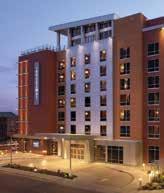



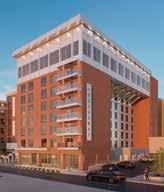






GFI DIGITAL HAS A STOCKED SERVICE CENTER IN ST. LOUIS, MISSOURI
By Bruce Gibbs
At GFI Digital, we’re always looking ahead to meet the needs of our customers—and that means staying fully stocked, fully prepared, and ready to deliver. Having a vast inventory of copiers and printers increases our capabilities to serve businesses of all sizes more efficiently.

BRUCE GIBBS Founder & President

These aren’t just boxes—they’re part of a commitment. Every copier that comes through our doors is backed by the expert care, service, and support our customers have come to trust. From enterpriselevel devices built for high-volume environments to compact solutions perfect for smaller teams, this shipment represents the latest in reliable, highperformance office technology.

(media contact) marketing@gfidigital.com (general) (877) 434-0012
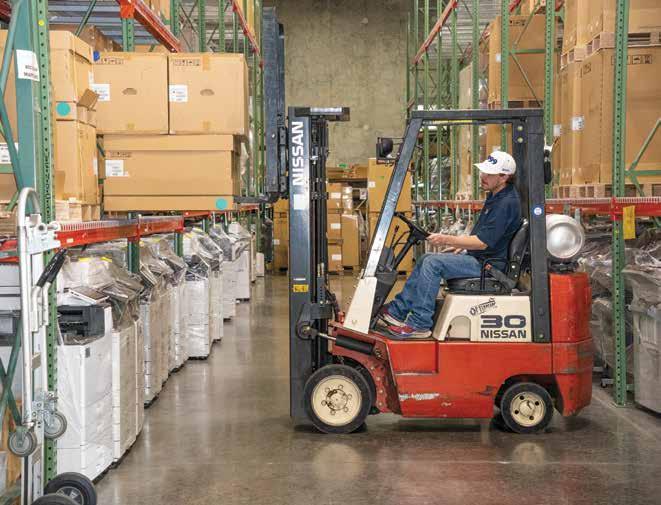
Whether you’re expanding your fleet, upgrading outdated equipment, or just starting to explore the best solution for your office, our team is here to help match you with the right device—fast.
And because these machines are already in-house, we can get them prepped, configured, and delivered with speed and precision, ensuring minimal downtime and maximum productivity. Need a new copier or service plan? Contact GFI Digital today.
Visit our website (gfidigital.com) to learn more about our copier and printer service.
IF YOUR BUSINESS HAS CHANGED, YOUR BRAND SHOULD TOO
By Charles Bruce III charles@comocompanies.com
Businesses evolve. Whether it’s adding new services, shifting your target audience, embracing new values, or expanding into new markets, change is often a sign of growth. But while operations, offerings, and teams may transform over time, many businesses forget to ask an important question: Does our brand still reflect who we are today?
If your business has changed, your brand should too.
Your brand is more than a logo or a catchy tagline — it’s the personality, voice, and visual identity that people associate with your business. It’s how customers perceive you, what they expect from you, and why they choose you over competitors. When your business evolves but your brand stays stuck in the past, a disconnect can form. And that disconnect can cost you credibility, clarity, and customers.
Why Alignment Matters
Let’s say you started your business as a solo freelance operation, offering simple services to local clients. But now, years later, you’ve grown into a full-fledged agency with a team, expanded services, and clients across the region. If your brand still feels like a one-person show, it may confuse potential customers or sell your business short.
Or perhaps you originally targeted budget-conscious consumers, but over time, you’ve shifted toward premium offerings and high-touch service. If your visuals, messaging, and tone still scream “discount,” you’re likely attracting the wrong audience—and repelling the right one.
In short, when your brand doesn’t reflect your current reality, it creates friction. Customers may misunderstand what you do, or worse, overlook you altogether.

CHARLES BRUCE III Director of Client Relations
Charles Bruce is the Director of Client Relations for COMO Companies which owns COMO Marketing, COMO Magazine, and COMO Business Times. He received his Bachelor’s Degree in Business Administration and his MBA from the University of Dubuque. When Charles isn’t being the life of the party, he can be found climbing a large mountain. In December 2023 he climbed the Imja Tse mountain in Nepal.
573-577-1965 | comomarketing.co
Signs It’s Time for a Brand Refresh
So, how do you know if your brand needs an update? Here are a few common signs:
• You’ve changed your products, services, or business model
• Your target audience has shifted
• You’ve entered a new market or industry
• You’re struggling to stand out from competitors
• Your current branding feels outdated
• Employees have a hard time explaining what your company does
• Customers seem confused about your offerings or identity
If any of these resonate, it’s time to take a closer look at your brand.
What a Brand Refresh Can Do for You
A thoughtful brand refresh or rebrand can breathe new life into your business. It’s an opportunity to clarify your message, strengthen your visual identity, and reconnect with your ideal audience. Here’s what that process might include:
• Refining your brand voice and messaging: Are you speaking the same language as your audience? Does your tone reflect your values and personality?
• Updating your logo and visual identity: Colors, fonts, and graphics all
communicate subtle messages. Make sure yours are saying the right thing.
• Redefining your brand values and mission: If your “why” has evolved, your brand should reflect that deeper purpose.
• Reassessing your customer experience: Branding isn’t just what people see—it’s what they feel. From your website to your customer service, the experience should align with your identity.
Embrace Change With Confidence
Rebranding doesn’t mean abandoning your history — it means building on it. It’s about honoring where you started while boldly stepping into who you’ve become. And you don’t have to do it all at once. Start with small changes that align your message and visuals with your current direction. Then, as your business continues to evolve, your brand will grow with you.
Your brand is a living, breathing extension of your business. If you’ve grown, pivoted, or changed direction, it deserves to grow too. A brand that reflects who you are now is one that will attract the right customers, build trust, and support your continued success.
Don’t be afraid to evolve. Your future customers — and your current ones — will thank you.
GET TO KNOW OUR NEW COLUMBIA BRANCH MANAGER
By Brad Roling broling@midambk.com
We have welcomed a few new, friendly faces into the Columbia branch and I’d like for you to get to know them too. Let’s hear from John Meyers, Branch Manager.
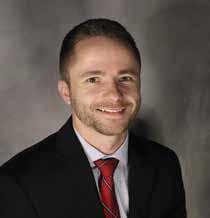
Hello, I’m John Meyers! Prior to being in the finance industry, I spent 8 years in the United States Marine Corps. I am the Brach Manager of our new Columbia Branch, where I oversee the day-to-day operations of our customer service representatives and tellers. When I’m not helping clients open new checking accounts, you can find me spending time with my family and watching the Rams lose in disappointing fashion.
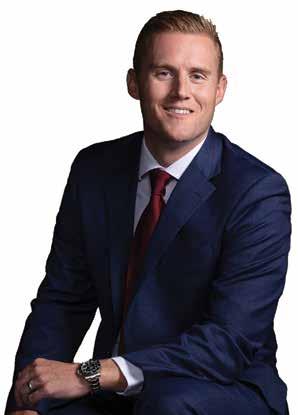
What do you enjoy most about banking? It is rewarding to see the impact that a banking relationship has on clients and their goals. Having the right banking partner sets you up for success, thus transforming our communities in a positive way.
Tell us about your path to becoming a branch manager. My dad was an accountant, so I was around finance from a young age. After serving in the military, I realized how much I enjoyed working with people, so banking felt like the perfect fit because it let me combine that background in finance with a role that is really centered around helping people.
If you could tell prospective clients one thing, what would it be? Allow your banking partner to get to know you. When we have a clear picture of your priorities, we can provide tailored solutions to help you achieve your financial goals. You don’t need grand plans,


Brad Roling is the Columbia Market President for Mid America Bank. Brad has more than 10 years of banking experience that he uses to help businesses in and around Columbia thrive. When he is not helping your business with its financial needs, Brad is serving the community in a variety of capacities. He is proud to serve on the Ronald McDonald House Mid-Missouri Board of Directors as Treasurer, the Columbia Chamber Foundation Board as Treasurer, Heart of Missouri United Way Board of Directors, Executive Board for Scouting America, Great Rivers Council, and Beta Theta Pi Advisory Board. Brad is a proud Mizzou grad and loves cheering on the Tigers!

| midambk.com
either. Sometimes you just need a checking account that gives you tools to manage your money, or a savings account that is dedicated to a specific financial goal. All financial goals are important.
What’s your secret to staying organized during the busiest times of day? I try to stay a step ahead by planning the day early, but the real key is knowing when to pivot. Things rarely go exactly as expected, so I focus on communication with my team, staying calm, and tackling one thing at a time.
If you could instantly master any skill outside of finance, what would it be? If I could master any skill, it would definitely be cooking. Who doesn’t love to eat delicious food?
Scan the QR code to learn more about John!
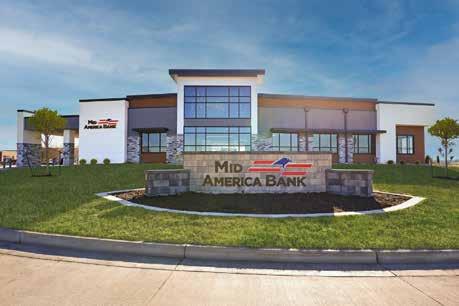
WHY PROST BUILDERS, A CENTRAL MISSOURI HOMEGROWN GENERAL CONTRACTOR, IS A BETTER CHOICE THAN AN OUT-OF-TOWN COMPETITOR
By Vaughn Prost info@prostbuilders.com
When it comes to choosing a general contractor or designbuilder for your construction project-be it a commercial or institutional facility-one name stands out in Central MissouriPROST BUILDERS. As one of the largest general contractor/design-builders in the state, they have deep relationships with local communities, subcontractors, and regulatory agencies. Out-of-town builders may boast of national portfolios, but they simply can’t match the local expertise, responsiveness, and commitment that Prost Builders brings to the table.
Here are more reasons to go local when constructing your new facility:
Deep Local Knowledge and Regulatory Expertise: Building in Central Missouri requires more than technical abilities-it demands a nuanced understanding of local state and municipal regulations, building codes, and permitting processes. Prost Builders has been operating in Central Missouri for over 76 years, giving them a clear advantage when navigating local regulations, whereas out-of-town companies face delays and added costs due to their unfamiliarity.
A Proven Track Record Across Central Missouri: Prost Builders isn’t new to

VAUGHN PROST Owner & President
Vaughn Prost is the owner and president of Prost Builders lnc., a design/build and construction services firm located in Columbia. Vaughn has over forty years of domestic and international design and construction experience as a cost and scheduling engineer, structural engineer, owner’s construction representative, and general contractor.
the scene-their portfolio includes a wide range of successful public and private projects across the state-from fire and police stations, to healthcare, educational facilities, and churches. Their reputation is built not only on project delivery to a satisfied client, but on repeat business and referrals in Central Missouri communities. That level of trust takes decades to earn, and out-of-state companies can’t replicate that reputation overnight.
A Commitment to Central Missouri’s Growth: Prost Builders isn’t just ‘doing business’ in the state--they live here, raise their families here, and are invested in the local community’s long-term success. They care about how a building fits into the community, how it supports local employment, and how it serves the public good. Out-of-town companies often bring in workers from out-of-state and while they’re focused on profit--Prost Builders always focuses on client satisfaction.
Out-of-Town Companies Don’t Understand the Nuances of Central Missouri: With a deep understanding of local pricing, weather patterns that affect a project schedule, and construction cycles-Prost Builders delivers accurate estimates and realistic timelines. They
(573) 635-0211 | prostbuilders.com 3305 Crawford Street Columbia, MO 65203
don’t have out-of-town overhead like; per diem costs, higher mobilization costs, premium markups, and administrative bloat that drives up budgets. They also know skilled, reliable, Central Missouribased subcontractors--which means more competitive pricing and higher quality work versus out-of-town companies that bring in outside labor, disrupt our local economies, and potentially face logistical challenges that lead to project delays.
Local Presence Means Faster Responses: Issues don’t wait for normal Monday to Friday business hours, so having a general contractor outside the area can cause delays in addressing onsite challenges that Prost Builders can address immediately. Working with Prost Builders means more frequent site visits, real time problem-solving, and their handson approach to managing timelines and quality control on the project. Their local proximity ensures that they’re always a short drive away instead of a conference call or an hours long drive away.
When you’re ready to plan your next project--start with homegrown Central Missouri Prost Builders, because we’ve been creating quality buildings here for over 76 years.
A Legacy
De ning

The University of Missouri stands the tests of time for multiple generations.
BY MATT FETTERLY
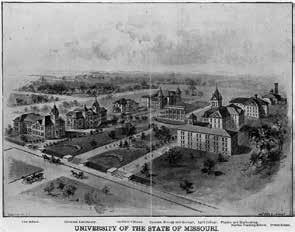
Igoverning body on the condition that the state university be established here. In the early 1800s, this region of mid-Missouri along the Missouri River, known as “ e Boonslick,” was populated by Virginians and Kentuckians who deeply valued knowledge and education as the foundation of the young American democracy.
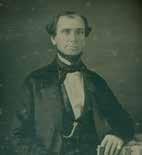
What we now call Missouri had recently been added to the United States with the Louisiana Purchase of 1804 under President omas Je erson, the father of the University of Virginia. It was undoubtedly similar ideals that inspired James S. Rollins, the father of the University of Missouri. Jeffersonians were opposed to elitism, the idea that only nobility or landowners should have a say in government. Although at that time their limited vision was only as broad as white males, they asserted that citizens had a right to be informed and have a say in government, including a right to an education, no matter their status in life.
James S. R lins
t is no exaggeration to claim that the history of the United States would be very di erent without the University of Missouri. As we approach the school’s 200th birthday and consider its standing as a global university, we are forced to appreciate that there are now far too many contributions to list. e university is in large part a result of the people of Columbia, but now, more than ever, the city is also a result of the university, and neither can be understood without understanding the other.
e idea that Columbia should be an educational center has deep roots to the city’s genesis. At Columbia’s founding in 1821, when only a few log cabins stood in an ancient forest clearing, the Smithton Company donated ten acres of land to Boone County’s
As a result, it is no accident the rst public university west of the Mississippi River — from Je erson’s Louisiana Purchase — was birthed in central Missouri from a town whose name is a national personication of the United States and goddess of liberty.
ough Missouri became a state in 1821, it would be years before the state legislature took action to organize a state university. Despite the delay, support for higher education in Columbia was moving ahead. A meeting took place at the Boone County Courthouse on August 9, 1831, for the purpose of founding a college. Funds were raised, and in 1833 the college was o cially chartered as “Columbia College.” Confusingly, it has no relation to today’s Columbia College. e founders had the foresight to predict that the state legislature would take up the issue of a state university and that they would likely place it in a centrally located town that had already demonstrated support for education by establishing a local college.
e rst building was a two-story brick structure that was erected on South 6th Street, at the present location of the Missouri State Teachers Association. Columbia College has been rightfully called “the seed that grew the university.” It was open from 1833 until the establishment of the University of Missouri.
A state university was nally authorized by the legislature in 1839, after a decade of discussion. One of the chief advocates was state Rep. James S. Rollins, a young lawyer from Columbia whose father was one of the trustees of Columbia College. State leaders considered a bill to choose the location of the university, requiring that it have at least forty acres of land and be located within two miles of a county seat among six central Missouri counties — Cole, Cooper, Boone, Saline, Howard, and Callaway. e six counties submitted bids of money and land.
ere was little interest from the three counties south of the Missouri River (Cole, Cooper, and Saline), but erce competition arose among Howard, Boone, and Callaway. When the Boone County delegation learned that the Howard County group had purchased 200 acres near Fayette, the local delegation purchased 220 acres of James S. Rollins’ farm on Columbia’s south border.
at’s the land where Francis Quadrangle stands today.
To get fundraising started, 904 individual Boone Countians donated money. Some gave only a few dollars, but three people donated $3,000, an extremely large amount of money at the time. One of the high-end donors was Edward Camplin, who could neither read nor write but was an accomplished businessman and a large landowner.
e university’s construction began in earnest in 1840 with the laying of the cornerstone of Academic Hall, a great domed building in the Greek Revival style, fronted with six ionic columns, a deliberate acknowledgement of the classical world of ancient Greece and its in uence on our edgling Republic. Columbia soon earned the nickname “the Athens of Missouri," as Athens — the birthplace of democracy — was an ancient center of art, learning, and philosophy.
e lyrics of the Old Missouri, the alma mater, still proclaim: “Proud art thou in classic beauty of thy noble past.” Indeed,
for admission into the university in those early days, a student had to be pro cient in both ancient Greek and Latin, in addition to mathematics. at naturally limited enrollment to both those who had the means to access a good high school education, along with the means to pay university tuition. At rst, students came mostly from Boone County, but gradually the old counties along the Missouri River began sending students.
Few graduated in those early years. ose who did often went on to become prominent leaders in law, business, politics or became teachers. e rst graduating class was in 1843 and consisted of two cousins, Robert L. Todd and Robert B. Todd. e edgling university heavily emphasized the ability to speak convincingly in debate and oratory. As a result, two rival student literary societies sprang up: the Athenaeum Literary Society and the Union Literary Society. ose were the rst student organizations and were secret societies devoted to debating and orating the topics of the day.
What did they debate? Topics included: “Is it probable that the Union will exist in one hundred years?” “Should a protective tari be established in the United States?” “Should women be allowed the right of suffrage?” “Should Congress legislate on the subject of slavery?” “Is conscience innate?” and “Can the immortality of the soul be proved by the lights of nature?”
e university has always struggled with being a political football, perceived as too beholden to one party or the other.
Never was this truer than during the years of the American Civil War. e situation in Columbia was complex; folks had sympathy to both sides. Columbia was a slave-owning area, and much of the wealth of the early university was vested in that institution, directly or indirectly. James S. Rollins was a large slave owner, yet also a key ally of Abraham Lincoln. His vote was pivotal in passing the irteenth Amendment, which abolished slavery in the United States.
e Union Army occupied Academic Hall during the war, making class work impossible; the upper stories were used as a jail, and library books were burned for warmth. A lawsuit for damages was led after the war, and the payout was used to construct the gateway to campus at Eighth and Elm streets. e Missouri Tiger nickname comes from a loyal band of citizens who protected Columbia from Confederate guerillas during the war. When the guerillas threatened to burn Columbia to the ground, the Missouri Tigers built a blockhouse around the city well in the middle of Eighth and Broadway and stationed a sniper in the cupola of the Boone County Courthouse.
e fearsome reputation of the Tigers stalwart defense spread, and the Confederates never attacked. When an imposing athletic mascot was needed a few decades later, the Missouri Tiger name was chosen. e most catastrophic, but ultimately bene cial, event in university history was the Great Fire of 1892 that burned Academic Hall to ruins. It resulted in the
e Great Fire 1892
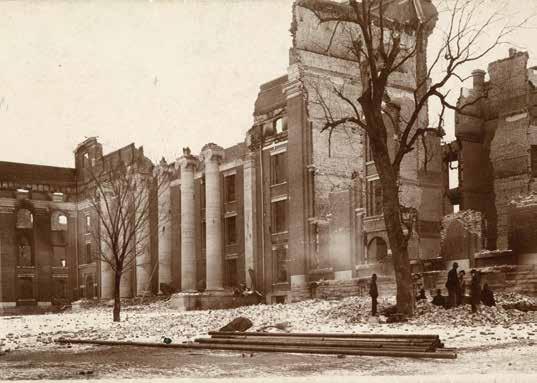

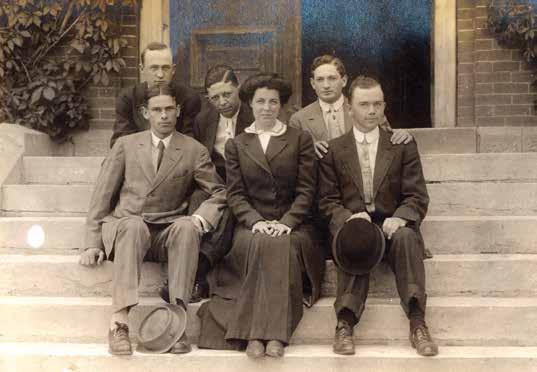
J rnalism Students
destruction of valuable records, artwork, library books, scienti c apparatus, and, of course, most of the university’s classroom space. It was also deeply traumatic for the early graduates, faculty, and sta . When Board of Curators President Gideon Rothwell ordered the old columns of Academic Hall torn down by a team of mules, Columbia resident Jerry Dorsey confronted Rothwell on the street. A heated exchange of words followed. Rothwell struck Dorsey, and a st ght ensued. Ultimately Gardiner Lathrop, president of the Alumni Association, made a tearful and impassioned plea to the Curators, and Rothwell had a change of heart, famously remarking, “Let the columns stand. Let them stand for 1,000 years.”
Who among us today can calculate the true value of that profound act of historic preservation?
e modern university was born out of the fertile ashes of the great re, and a new Academic Hall was raised under the leadership of President Richard Jesse and Governor David R. Francis. ey employed Morris Frederick Bell, Missouri’s well-known institutional architect, to build one of the nest and most dramatic university quadrangles in the world. However, it was not mere buildings inspiring the renaissance of the university, but Jesse’s capable leadership that attracted young, intelligent, vigorous faculty members. When faced with complaints about lack of funding from the legislature compared to Missouri’s peer states, Jesse soothed the faculty saying something to the e ect of, “Never you mind, we will do four times as much with twice as little.”
And he was right. e university entered into a growth phase, enrollment increased, the graduate school was founded, William Pommer was hired as the rst instructor of music, and nally, in Jesse's last year as president, the the School of Journalism — the world’s rst — was created. Walter Williams was a Boonville printer’s devil, an apprentice in the newspaper industry with no college education. He was hired by prominent Columbian E.W. Stephens to work as editor of the Columbia Herald newspaper. e two men shared a dream of elevating their profession by creating a school for journalism. After years of defeats in the legislature, they achieved it in 1908 with Williams as the rst dean.
e “Missouri Method” of journalism involved hands-on practical education that rst included publishing a newspaper, e Missourian, but eventually expanded to radio, TV, and the internet. Today, MU School of Journalism alumni are so ubiquitous in the media industry, they are referred to as the “Missouri Ma a.” e e ect on Columbia has been an unusual, perhaps unique in the nation, saturation of the city with inquiring minds and documentarians. Columbia is one of the smallest cities in America with two daily newspapers. e community is also rich in locally controlled and focused media, from KOPN and KBIA to KOMU and ABC17.
And radio station KFRU will celebrate its 100th anniversary in October.
It is Columbia’s environment what nurtured the growth of the True/False Film Fest, known internationally for its documentary focus. It was largely journalists,
with the help of historians, who founded the State Historical Society of Missouri, and Columbia is also unusual for the nearly complete record of local newspapers preserved there.
e newspapers document the history of the agship university navigating waves of societal change, sometimes leading the way — other times lagging behind. In the 1930s, Lloyd Gaines, an African American, applied for admission to the School of Law and was refused. Gaines sued, resulting in an important early civil rights case before the U.S. Supreme Court. However, Black students would not be enrolled until 1950.
In the 1940s, E.K. Johnston, a beloved professor and acting dean of the J-School, was arrested and accused of being a homosexual. He was red without trial, publicly smeared, tried, and sentenced to probation with the orders to cease all “homosexual practices.” So began a decades-long purge of LGBT students and faculty. LGBT students were not bound by the limitations of their school’s shortsighted policy. In 1939, alumna Francis Rumell published under a pseudonym one of the earliest lesbian autobiographies, Diana: A Strange Autobiography. Alumna Marijane Meaker wrote Spring Fire, which alludes to her experience in an MU sorority. Published in 1959, it's considered the rst lesbian paperback novel.
e landmark 1970s court case Gay Lib vs. University of Missouri determined that the university had no right to restrict speech or association “simply because it nds the views expressed to be abhorrent.” Universities have always been battlegrounds for ideas and likely always will be. e case is taught in law schools everywhere.
e university in 2025 remains the beating heart of Columbia, pumping new ideas and new people into and out of town. Many stay and contribute to our growing Midwestern metropolis. Could that rst graduating class of two imagine an institution of more than 30,000 students, some 10,000 employees, multiple hospitals, arenas, stadiums, a nuclear reactor, theaters, recital halls, galleries, laboratory buildings, and a courtroom?
Columbians still live in the Athens of Missouri, and in that spirit of the old Atheneaeum Literary Society, perhaps a fresh debate topic is worth exploring: “Will the University of Missouri still exist in 100 years — and what will that university look like?” CBT
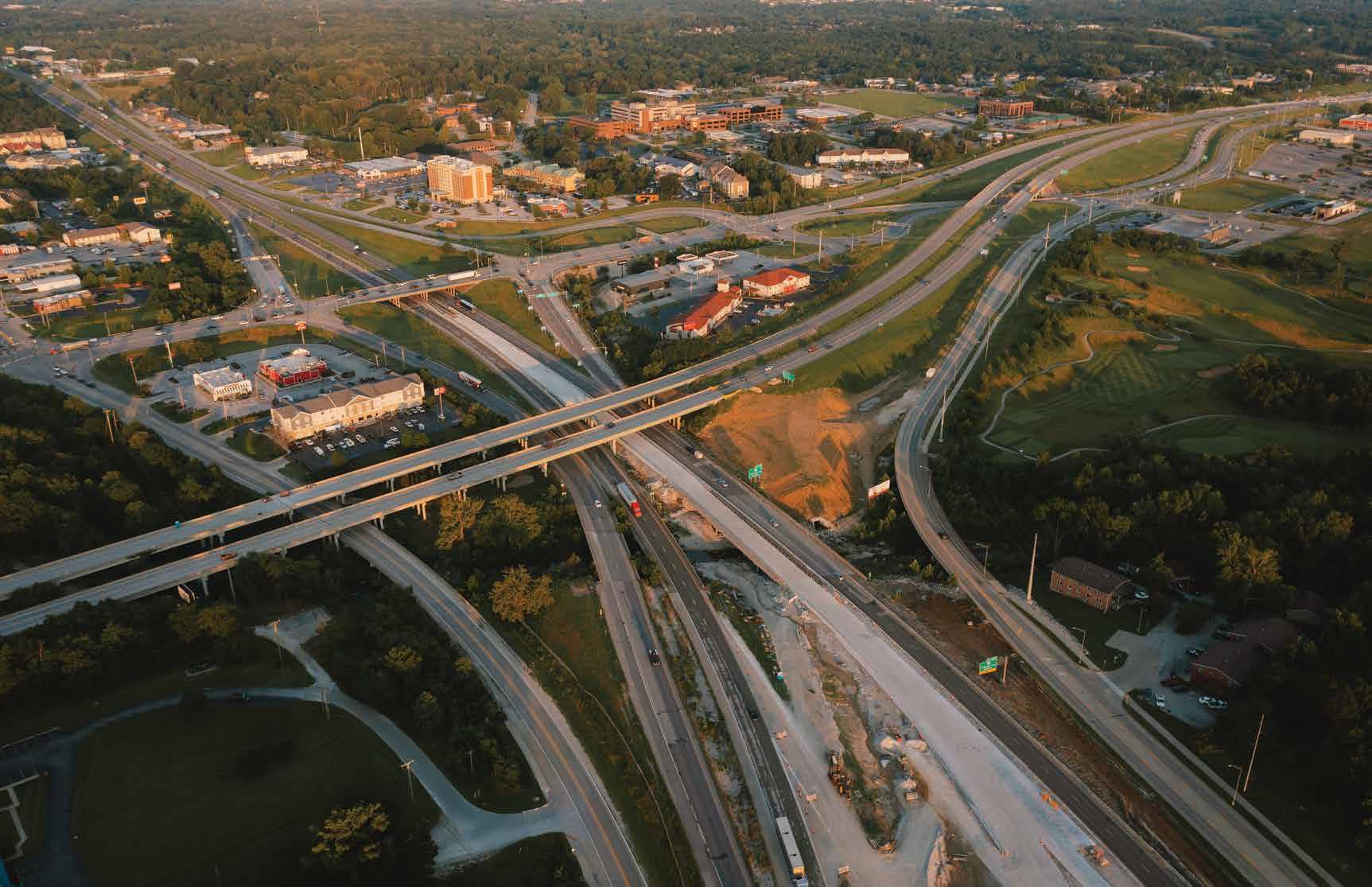
TRANSIT IN Transition

Columbia is the ‘bookend’ for a generational I-70 improvement project.
BY
JODIE JACKSO N JR
PHOTOS BY KEITH BOR GMEYER


What would Columbia, Missouri, be like today without the storied institutions that continue to generate immeasurable economic activity, deeply rooted in education and medicine? Without businesses — from insurance and nance to homegrown entrepreneurial success stories — that are uniquely Columbia?
Now imagine what would have happened if the stagecoach route between Kansas City and St. Louis had bypassed Columbia back in the day. Imagine Columbia without Interstate 70, the state’s busiest thoroughfare, which bisects the city roughly halfway between Kansas City and St. Louis.
At nearly seventy years old, I-70 is the most recent incarnation of a cross-state transportation corridor through Columbia, and it is getting a major overhaul — to the tune of $2.8 billion. e work is expected to wrap up by the end of 2030.
It seems tting, too, that the addition of a third lane in each direction between Blue Springs to the west and St. Charles to the east has a distinct Columbia focus. While the massive cross-state I-70 project, which the Missouri Department of Transportation (MoDOT) calls “Improve I-70,” will be completed in multiple phases, Columbia will serve as “reverse bookends” for the multi-year project, said Columbia Chamber of Commerce President and CEO Matt McCormick.
“It starts and nishes in Columbia,” McCormick noted. He credits decades of MoDOT and city cooperation for Columbia’s good standing. e project began last summer with the stretch from Columbia to Kingdom City — the stretch that is currently gnarling several sections of roadway on and o I-70 — and will end with I-70 improvements from Boonville to Columbia. McCormick said that getting the cumbersome U.S. Highway 63/I70 connector - sometimes referred to as “spaghetti junction” — on the state’s revenue and budget radar “opened the door for all of I-70" to be improved.
MoDOT’s Improve I-70 project manager con rmed the conclusion that the section from U.S. Highway 63 in Columbia to U.S. Highway 54 at Kingdom City was chosen because other work had already been planned to rebuild both intersections.
“ at section really made sense for us to get a quick start and begin construction
later this spring or early summer,” said Eric Kopinski, director of the Improve I-70 Program. “Had we looked at a larger section or incorporated a larger contract, our start would have been much delayed.”
e Columbia intersection of Highway 63 and I-70 is notoriously congested. e makeover and reconstruction plan calls for redirecting as much as 60 percent of local tra c away from the rebuilt interchange. Columbia’s connector will be replaced with four roundabouts, a new bridge, and a new collector road. Project Director Je Gander said some of the terminology might not be familiar to all motorists, “but it’s really cool and it’s going to work really well.” He added, “It’s going to be like nothing you’ve ever seen, but it is going to function very well.”
McCormick echoed the “generational” and “one-in-a-lifetime" descriptions that others have used about the massive project. “ e 70/63 corridor is probably one of the most important tra c corridors in the state,” he said. “And this is probably one of the most important projects we’ve had in the state.”
Functionality has always been the focus, whether the mode of travel was horse and buggy or eighteen-wheel semi. Originally located about seven miles north of Columbia, the Boonslick Road was relocated in 1822 to pass through Columbia on what is now Broadway, making Columbia the retail center for an extended trade area. As a burgeoning economic hub, Columbia became the halfway point stop for stagecoaches traveling between Kansas City and St. Louis.
e original U.S. Highway 40 also passed along Broadway through the center of Columbia’s business district until it was relocated several blocks north of Broadway to what was then the urban fringe. (Now we call it Business Loop 70.) Highway 40 was constructed on a rather narrow right of way with uncontrolled access. Not surprisingly, commercial development quickly grew along the road and became extensive, bringing increased tra c congestion and accidents.
In 1948, Highway 40 was widened and resurfaced, and even after I-70 was under construction a decade later, Highway 40 was again widened, and a median was installed to reduce accidents.
en came the birth of the interstate highway system, a post-WWII
infrastructure development that had been delayed by lack of funding and a short-lived rebellion against urbanization of rural areas via a massive highway.
While both Missouri and Kansas lay claim to being the “ rst” with an I-70 project, the most authoritative sources report that following the signing of the Federal-Aid Highway Act of 1956 by President Eisenhower on June 29, 1956, Missouri moved quickly to orient its highway program toward the enormous task of planning and constructing the state’s eventual 1,181-mile Interstate system.
According to MoDOT, Missouri was the rst state to award an Interstate construction contract. On August 2, 1956, the state awarded contracts for a portion of Interstate 44 in Laclede County and a portion of Interstate 70 in St. Charles County. e rst interstate project under construction on I-70 was in St. Charles County between Fifth Street and Route 94/First Capitol Drive. at project broke ground on Aug. 13, 1956.
e following summer, construction began on the corridor through Columbia, and that section of the brand-new I-70 was opened in 1958. Columbia’s portion of the new I-70 was one of the rst out-state segments to be built. It consisted of 7.3 miles of dual-lane limited access highway beginning near Conley Lane (now known as Stadium Boulevard) eastward to about 2.6 miles east of the city limits. Although it was considered a bypass at the time, the city grew and enveloped the highway.
Writing about the birth of I-70 for the Columbia Business Times in 2007, former Columbia City Manager Ray Beck said the rules of road construction in 1957 and 1958 bene ted the city in ways that would not be possible now. By today’s rules, he wrote, the interchanges are spaced too closely together, so more interchanges were approved for Columbia than would ever be approved today, “but I believe the extra exits have been a real plus for our city.”
Eisenhower’s National System of Interstate and Defense Highways was called the most ambitious public works project built since the Roman Empire. Whether that is hyperbole or a simple statement of fact, I-70 is a critical link in the nation’s and Missouri’s transportation system. Columbia’s geographic location certainly had serendipitous good fortune, because it is intersected by both I-70 and Highway 63.
e gravity of that point is worth stating, because a city’s growth is tied to transportation and commerce. Since the Interstate Highway System began in the 1950s, the more successful cities have been located on the interstates.
“When you build one, new buildings usually follow, especially hotels and restaurants, at the interchanges,” Beck wrote nearly twenty years ago.
Back to the present, MoDOT is eyeing
a future of more e cient and safer travel.
e $2.8 billion Improve I-70 initiative was a major component of the 2024 state budget signed by then-Gov. Mike Parson, who was in Columbia among the dignitaries at an o cial groundbreaking ceremony for the overall project.
“ is is a major challenge to deliver, but our MoDOT team working alongside the private sector partners in engineering and construction will deliver,” said Terry
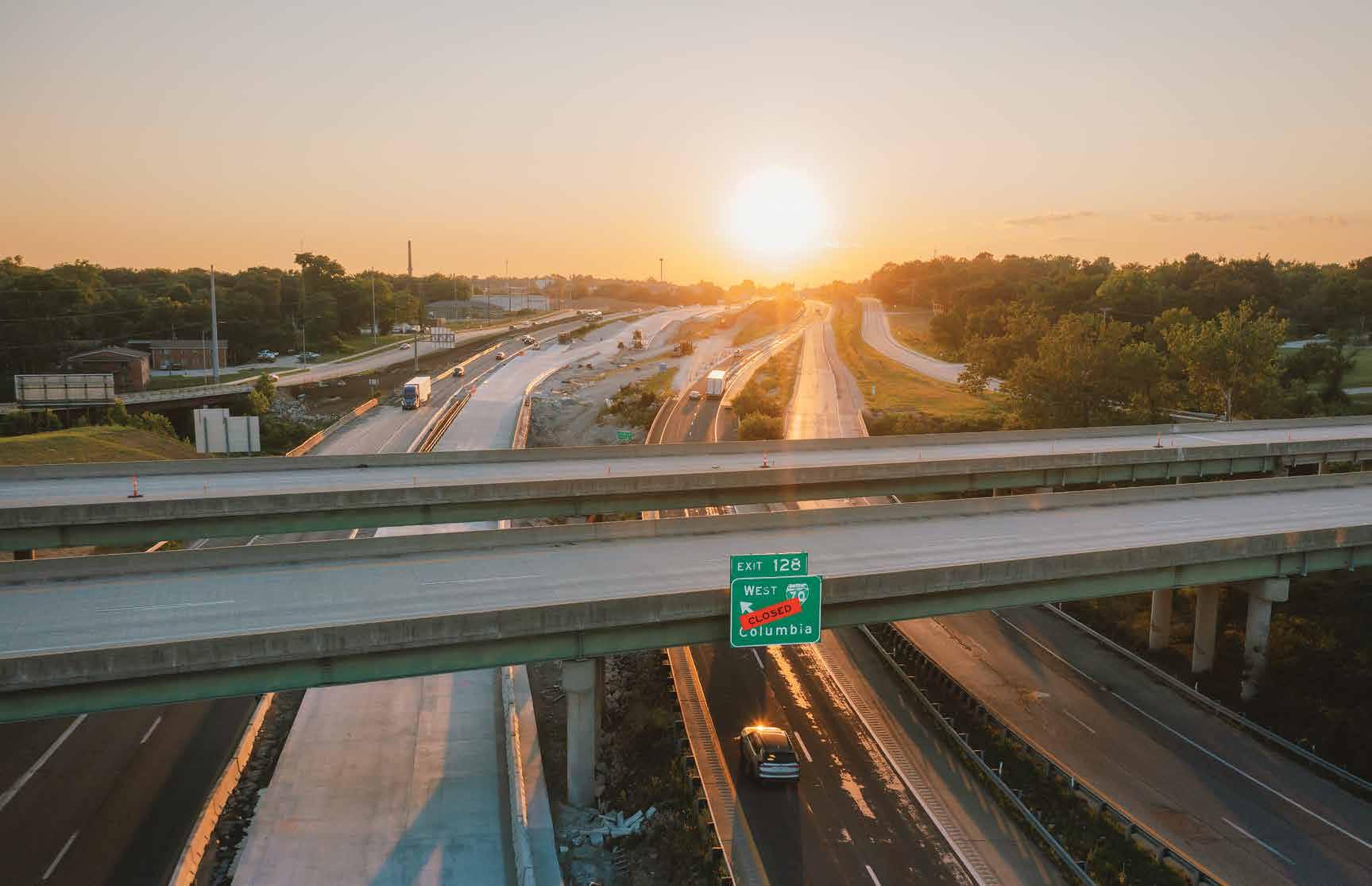
Ecker, chairman of the Missouri Highways and Transportation Commission.
McCormick said the plan to keep trafc owing throughout the project was a bonus that should minimize delays for motorists. Two lanes will be open for trafc in both directions across the state throughout the project.
Local leaders also wanted to challenge MoDOT to go a step beyond and create an attractive, welcoming intersection for
70 and 63. A group of local business owners that involved Chamber of Commerce leadership mustered ideas and support for beautifying the new interchange with stonework, plants and trees, and other elements that match Columbia’s landscape and skyline. Some $3 million is included in that part of the project.
MoDOT hosted public meetings in Columbia and Kingdom City in early May 2024 to share plans about the project and
answer questions. MoDOT followed that pattern before construction got underway on other sections of the project.
Today, I-70 is a transcontinental highway stretching from Cove Fort, Utah, to Baltimore, Maryland. Its history includes both the initial planning and construction of the Interstate Highway System and the unique engineering challenges encountered in traversing the Rocky Mountains.

And now Columbia is the focus of a major step toward modernizing the oldest portion of I-70. Now imagine I-70 through Columbia seventy years from now.
“Whether you call the main highway the Boonslick Trail or the new Interstate 70,” Beck wrote, “travelers want to move through to their destination, and businesses try to entice them to stop and spend their money. It is important that the stagecoach still stops in our city.”

Street Talk
faces closure.
BY JODIE JACKSON JR
e Columbia Daily Tribune has reported that the downtown Columbia press facility that has long printed the Daily Tribune as well as other publications will cease operations in September, with printing and packaging moving to Gannett facilities in neighboring states. e last issues to be printed in Columbia will be on Sunday, Sept. 7, for the Monday, Sept. 8 editions. After that, printing of the Tribune, the Spring eld News-Leader and USA TODAY will shift to the Gannett publication facility in Des Moines, Iowa.
Founded in 1901, the Tribune was locally owned until 2016, when the Waters family sold the paper to Gatehouse Media, which in 2019 acquired Gannett and adopted that name.
Taking a Bite
Columbia/Boone County Public Health and Human Services (PHHS) has released its 2024 Communicable Disease Report, highlighting trends in reportable illnesses and public health risks across the county. e full 2024 Communicable Disease Report is available at CoMo.gov/Health/Data.
In 2024, PHHS saw a sharp rise in the number of reported bites, prompting concern and a call to action for the community.
Mareck Puts on the Brakes
e Columbia Missourian reported that Mareck Center for Dance will close Aug. 31 after nearly two decades of performances, education, and outreach, citing “unrelenting nancial
challenges.” Home to Columbia’s only professional dance company, the center also ran community initiatives such as DanceAbility, an inclusive program o ering adaptive dance classes for participants of all abilities.
While the school and company will cease operations, the Mareck Center for Dance nonpro t organization itself will remain in existence, according to the Missourian. Meanwhile, sta members and volunteers are reportedly trying to craft a plan to keep the center operating.
Tid-Bits
Missouri Gov. Mike Kehoe signed legislation repealing paid sick leave accrued by workers starting May 1. e repeal, e ective August 28, reverses a voter-approved minimum wage increase and paid sick leave initiative. Supporters of the original initiative criticize the repeal as an attack on workers, while proponents argue it protects small businesses.
Ragtag Cinema’s Show Me Series will partner with four community organizations for its fth edition, that begins in September. e series will explore social issues such as agriculture, race, history, and governance. e new partners are Columbia Center for Urban Agriculture; Race Matters, Friends; the state historical society; and the University of Missouri’s Truman School of Government and Public A airs.
e United States Department of Education has awarded Columbia College a renewal of its long-standing TRIO Student Support Services (SSS) grant, totaling $1.4 million over ve years. TRIO SSS works to improve college retention and graduation rates among low-income students, rst-generation students, and students with disabilities. Columbia College students have bene ted from the TRIO SSS grant since the program was established on Columbia College’s main campus in 2001. More than 170 Columbia College students participated in the program during the 2024-25 academic year, and nearly 200 students have graduated within the last ve-year grant cycle thanks to support from the TRIO SSS program.
City of Refuge has purchased a downtown Columbia property in an e ort to expand services for mid-Missouri’s refugee community, even as the organization faces the looming expiration of key federal funding. e nonpro t bought the building at 1 E. Broadway with the help of Boone County’s previously awarded American Rescue Act (ARPA) funds. e new space near the Columbia Public Library will house expanded immigration legal services, a future learning center, and a renovated commercial kitchen to accommodate culinary training. CBT

Street Talk is a monthly overview of “word on the street” business and community news. Street Talk is sponsored by e Bank of Missouri.
Tribune press facility will shutter, Mareck Dance
New Business Licenses
Issued June 2025
Skyline Food Truck and Catering LLC
14 E. Business Loop 70, Columbia
C and S Home Essentials
Retail trade
Sherri Harris
5909 W. Driskel Rd., Columbia
Select Hearing
Shawna Fling
303 N. Stadium, Columbia
JB Siding Windows and Doors LLC
Construction
Johnny Bargas
5615 E. Heller Rd., Columbia
Affinity Office Furniture, LLC
Retail trade
Breck Dumas and Don Corwin
1800 Burlington Street, Columbia
Ground Zero Utility Construction LLC
7513 County Road 363 New Bloom eld, MO
SHOW-ME-ECO LLC
General business license
Wilbert Minnis
2707 Quail Drive, Columbia
RF Installations, LLC
James Norman
1475 S. Avenue, Grand Prairie, Texas
Columbia Plumbing LLC
1 Tom Plumber of Columbia
5751 E. Highway 163, Columbia CBT


What’s Going Up?
Red Cross gets green light for new building.
BY JODIE JACKSON JR
DOMINO’S PIZZA is building a shop in Centralia and the AMERICAN RED CROSS is starting construction on a $5 million building in south Columbia. ose are among the highlights of the building permits issued in June by the city of Columbia’s Building and Site Development O ce and the Boone County Resource Management O ce.
Collectively, the city and county o ces issued 174 building permits with an aggregate valuation of $34.42 million. Columbia issued 101 permits with a total valuation of $26.79 million and Boone County’s report listed 73 permits totaling $7.63 million.
e city’s building permit breakdown for June included:
• Residential additions: 6 permits, $762,728 valuation.
• Commercial alterations: 14 permits, $6.3 million.
• Residential alterations: 11 permits, $469,245.
• Residential pool: 1 permit, $85,000.
• Commercial new construction: 2 permits, $5.1 million.
• Deck only: 4 permits, $93,590.
• Duplex: 2 permits, $674,166.
• Re-roof: 28 permits, $938,805.
• Single family dwelling: 30 permits, $11.77 million.
• Solar: 1 permit, $20,400.
• Townhouse: 2 permits, $589,000.
Highlights of the city’s June building permit report include:
A new single-story building for the AMERICAN RED CROSS is being built at 4604 Stellar Drive, near the new Mid America Bank and Veterans United Home Loans headquarters. e permit listed a valuation of $5 million for a nearly 14,000-squarefoot facility. Coil Construction is the contractor.
e LOCAL RED CROSS is relocating from 1511 S. Providence, which it leased from the University of Missouri. According to the permit, the new building will have o ce space, meeting room space, space for on-site trainings, a blood donor center, a staging site for mobile blood drives, and a distribution site for receiving incoming blood from o site lab processing sites and for distributing blood to local and area hospitals. e local Red Cross is the chapter for central and northeast Missouri, which covers twenty-seven counties stretching from the Iowa border to Fort Leonard Wood.
AURORA ORGANIC DAIRY at 4525 Waco Road in north Columbia will undertake a $2 million project for steam plant modi cations and wastewater treatment improvements. e general contractor is Big-D Construction Corporation of Salt Lake City, Utah. Aurora Organic Dairy’s Columbia plant opened in April 2019. e 127,000-squarefoot facility processes, bottles, and stores uid organic milk products for distribution to consumers.
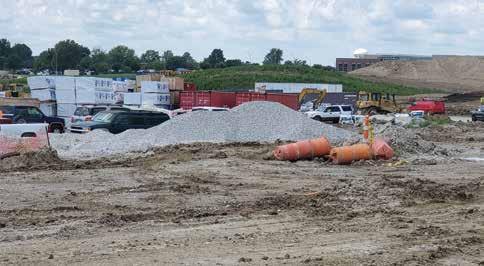
SPRINGBROOK
PARK APARTMENTS at 4005 State Farm Parkway are still under construction, but the new complex is already leasing units.
by Jodie Jackson Jr
An interior renovation of the city’s ASHLEY STREET CENTER at 1509 Ashley Street will add accessible shower rooms and other amenities. e permit valuation for the 13,727-square-foot project was listed as $650,000. e city purchased the center — formerly a VFW Hall — in late 2022 for the purpose of enhancing services for the community’s “most vulnerable members,” according to news reports at that time. e site became the permanent home of the Room at the Inn shelter and soup kitchen. Contractors on the project are Professional Contractors & Engineers Inc., Star Heating, SOA Architecture, all of Columbia, and Meyer Electric Company of Je erson City.
MISSOURI CREDIT UNION at 1310 Smiley Lane is getting a $552,277 interior makeover. Little Dixie
email jodie@comocompanies.com and let us know!
Photo


Construction is the contractor. e project for the 3,429-square-foot building includes interior alteration to the lobby and adjacent o ce space, providing new teller pods, private o ce space, and a new conference room.
An interior renovation project for the WILLIAMS KEEPERS o ce at 2005 W. Broadway, Suite 100, will provide upgrades to existing o ce spaces to include new o ces, support spaces, and nish replacements. Shelter Insurance is the property owner. e permit listed a $300,000 valuation for the 3,673-square-foot project. Coil Construction Inc. is the contractor.
BOONE RADIOLOGY CENTER at 1600 E. Broadway is getting interior nishes to create a new CT scanner room. e project has a $625,000 valuation. Septagon Construction is the contractor.
An existing suite is being remodeled and expanded in the DISCOVERY OFFICE PARK at 4210 Philips Farm Road, suite 105. Discovery Development LLC is the contractor for the $200,000 project that encompasses 5,600 square feet.
A pair of RESIDENTIAL DUPLEXES at 506 High Street in the J.A. Douglas Subdivision both have building permit valuations of $337,083. Justin Naydyhor of Columbia is the owner/ contractor. Subcontractors include Burnett’s Electric of Centralia, Synergy Plumbing LLC of Columbia, and B.G. Mechanical of Columbia.
TOWNHOUSES are going up at 811 Carlisle Court and 4809 Carlisle Court in the Bristol Lake development. Fairway Meadows Corporation is the general contractor. Both townhouses have valuations of $294,828.
e valuations for new single-family homes on the city’s building permit report range from $228,919 for a house o Boscoe Bel Drive, built by Hemme Construction LLC, to a $745,394 house o Brookedale Court in the Highlands. Wilcoxson Custom Homes, LLC is the builder.
Boone County’s building permit breakdown showed:
• Single family residential: 12 permits, $5.16 million.
• Modular/doublewide: 3 permits, $250,181.
• Stores/mercantile building: 1 permit, $520,000.
• Other non-residential: 5 permits, $305,530.
• Other structures: 10 permits, $365,510.
• Residential additions/alterations: 11 permits, $414,911.
• Nonresidential additions/ alterations: 7 permits, $170,000.
• Residential garages: 5 permits, $407,500.
• Miscellaneous: 19 permits, $29,854.
Highlights included:
A DOMINO’S PIZZA site at 251 W. Highway 22 in Centralia. e builder was listed as Wholf Building Companies. e permit listed a valuation of $520,000.
Single-family dwellings on the June building permit report ranged from $120,000 for a house on Stone Street in Sturgeon to a $1.3 MILLION home on South Cabot Links Drive in Columbia, with Fairway Meadows as the builder. CBT
The year The Minute Inn becomes the site of the first organized sit-in to protest segregation in Columbia. The Minute Inn later became Fran’s Diner, and then Broadway Diner.
100 Years KFRU has been on the air this October — marking a century since its first broadcast in 1925.
52
Years between the laying of Academic Hall’s cornerstone in 1840 — marking the start of construction on the University of Missouri — and its destruction by fire in 1892.
58,327
Population growth of Columbia during Ray Beck’s forty-six-year career as public works director and city manager from 1960 to 2006. Source: U.S. Census
1,080
Number of City Council meetings Ray Beck attended.
$405 million
Cost of adding a third lane in the east and westbound lanes of I-70 between Columbia and Kingdom City and replacing I-70 intersections with Highway 54 in Kingdom City and Highway 63 in Columbia.
$2.8 billion
Total cost of “Improve I-70,” the entire interstatewidening project from Blue Springs to Wentzville.
I-70 Rebuilding Inspires Roadway Archaeology
BY STEVE SPELLMAN
THE LONG-OVERDUE REBUILD OF INTER-

STATE 70 now underway is a once-in-a-generation project. e rst fresh pavement near Kingdom City had trafc diverted onto it this spring. e interchange at Highway 63 and I-70 is being worked up already, and construction on the section from there to the Missouri River bridge near Rocheport might start next year.
While the new road promises to be really great, I have some nostalgia already setting in. e Highway 63–I-70 interchange is currently mid-Missouri’s busiest crossroads, but can you imagine back in the day when its predecessor was Old Highway 63 and Highway 40 by Westlake Ace Hardware on the Business Loop?
For amateur roadway archeologists like me, the I-70 megaproject is an invitation to exhume the routes and highways of our city’s past. If you take the time to look, you’ll nd many of them hiding in plain sight. Let’s explore a few.
70, 40, HUT HUT, HIKE
Our modern superhighways were largely built out in the 1950s and ’60s. Before I-70, U.S. Highway 40 (now Business Loop 70 through town) was part the National Road from the East to the West Coast.
East of town, on past Westlake, it went straight toward the now Drury Plaza Hotel, then veered right around the grain bins. Today, Sunday drivers can hopscotch on access roads to discover where a town of Kingdom City actually does exist. West of Columbia, beyond Cosmo Park (formerly the site of our airport), Highway 40 went by ESS, then crossed south of the interstate, in a beautiful secluded stretch to back behind Black and Gold Auctions. Past Midway Golf and Games there now stands a unique curved bridge and historic marker. Proceeding beyond the Midway Travel Plaza, still-named Highway 40 is a back road to downtown Boonville.
An expanded I-70 is coming — but old roads have stories to tell. Scan the QR code to take a drive down memory lane.
Legacy in Gold: The Chamber Ambassadors
BY MATT M C CORMICK
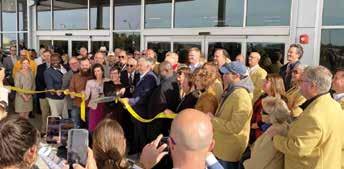
WHEN YOU SEE A FLASH OF GOLD at a Columbia Chamber of Commerce event, you know you’re in good company. For forty-four years, the Columbia Chamber’s ambassadors — a ectionately known as the “gold coats” — have served as the goodwill arm of the organization, weaving their presence into the very fabric of our business community. But beyond the eye-catching blazers and the ribbon-cutting photos, there lies a deeper story: one of connection, tradition, and a lasting legacy.
More than 100 members strong, the ambassadors represent a diverse mix of business leaders and representatives who give their time and energy to support their peers. eir primary mission is simple yet powerful: to show up. ey show up to welcome new chamber[KP1] members. ey show up to celebrate milestones. ey show up to serve as a bridge between business owners, customers, and the broader Columbia community.
At the heart of the ambassador program are the ceremonial duties: ribbon cuttings and groundbreakings. ese events are more than photo ops; they are a rite of passage for many entrepreneurs. In a given year, ambassadors attend and host more than 200 ribbon cuttings, each one marking a new chapter in someone’s business journey. Whether it’s a grand opening, an expansion, or the launch of a new product, these moments are worthy of pause, recognition, and celebration.
When you consider the cumulative e ect of these appearances, the legacy becomes clear. Over four decades and thousands of businesses later, the ambassadors have helped tell Columbia’s economic story, one ribbon at a time. ey’ve clapped, smiled, and stood proudly beside businesses at every stage, and in doing so, they’ve built a culture of encouragement and resilience.
It’s more than a ribbon cutting. Scan the QR code to discover how ambassadors help build Columbia’s business community. CBT

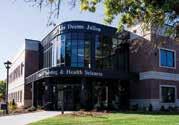



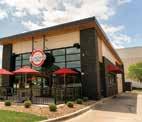

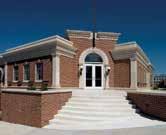
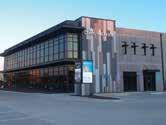

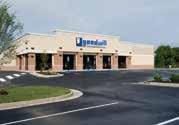




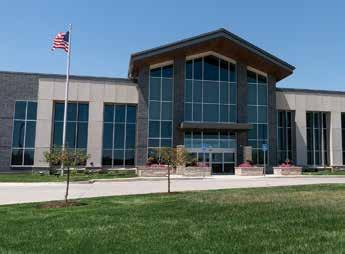

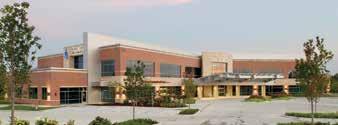
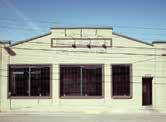

50 YEARS OF EXCELLENCE
Since 1975, Coil has been building a better community. This year we are celebrating the people, projects and progress that have shaped our journey.

